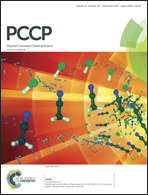Electrical conductivity of activated carbon–metal oxide nanocomposites under compression: a comparison study
Abstract
From a granular commercial activated carbon (AC) and six metal oxide (Al2O3, Fe2O3, SnO2, TiO2, WO3 and ZnO) precursors, two series of AC–metal oxide nanocomposites were prepared by wet impregnation, oven-drying at 120 °C, and subsequent heat treatment at 200 or 850 °C in an inert atmosphere. Here, the electrical conductivity of the resulting products was studied under moderate compression. The influence of the applied pressure, sample volume, mechanical work, and density of the hybrid materials was thoroughly investigated. The DC electrical conductivity of the compressed samples was measured at room temperature by the four-probe method. Compaction assays suggest that the mechanical properties of the nanocomposites are largely determined by the carbon matrix. Both the decrease in volume and the increase in density were relatively small and only significant at pressures lower than 100 kPa for AC and most nanocomposites. In contrast, the bulk electrical conductivity of the hybrid materials was strongly influenced by the intrinsic conductivity, mean crystallite size, content and chemical nature of the supported phases, which ultimately depend on the metal oxide precursor and heat treatment temperature. The supported nanoparticles may be considered to act as electrical switches either hindering or favouring the effective electron transport between the AC cores of neighbouring composite particles in contact under compression. Conductivity values as a rule were lower for the nanocomposites than for the raw AC, all of them falling in the range of semiconductor materials. With the increase in heat treatment temperature, the trend is toward the improvement of conductivity due to the increase in the crystallite size and, in some cases, to the formation of metals in the elemental state and even metal carbides. The patterns of variation of the electrical conductivity with pressure and mechanical work were slightly similar, thus suggesting the predominance of the pressure effects rather than the volume ones.


 Please wait while we load your content...
Please wait while we load your content...